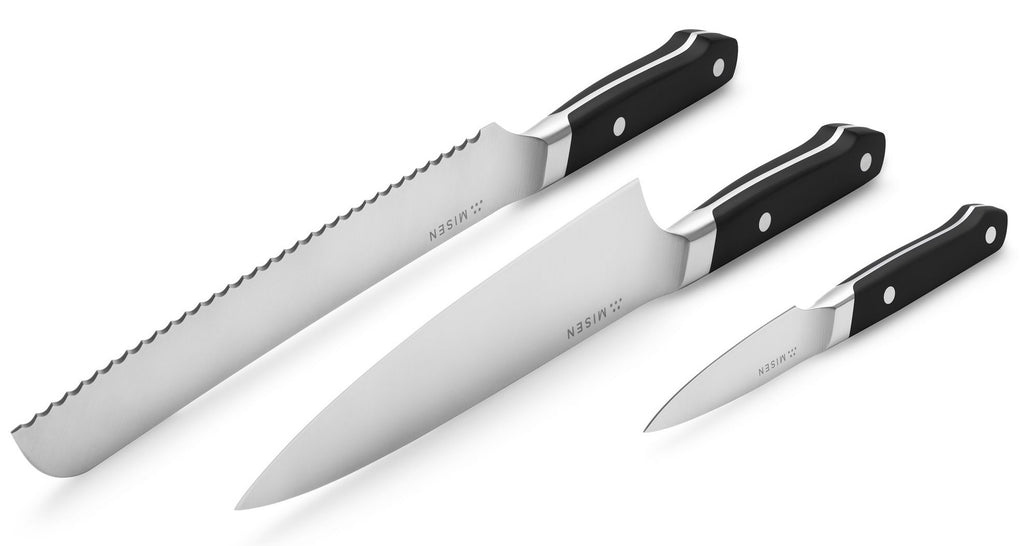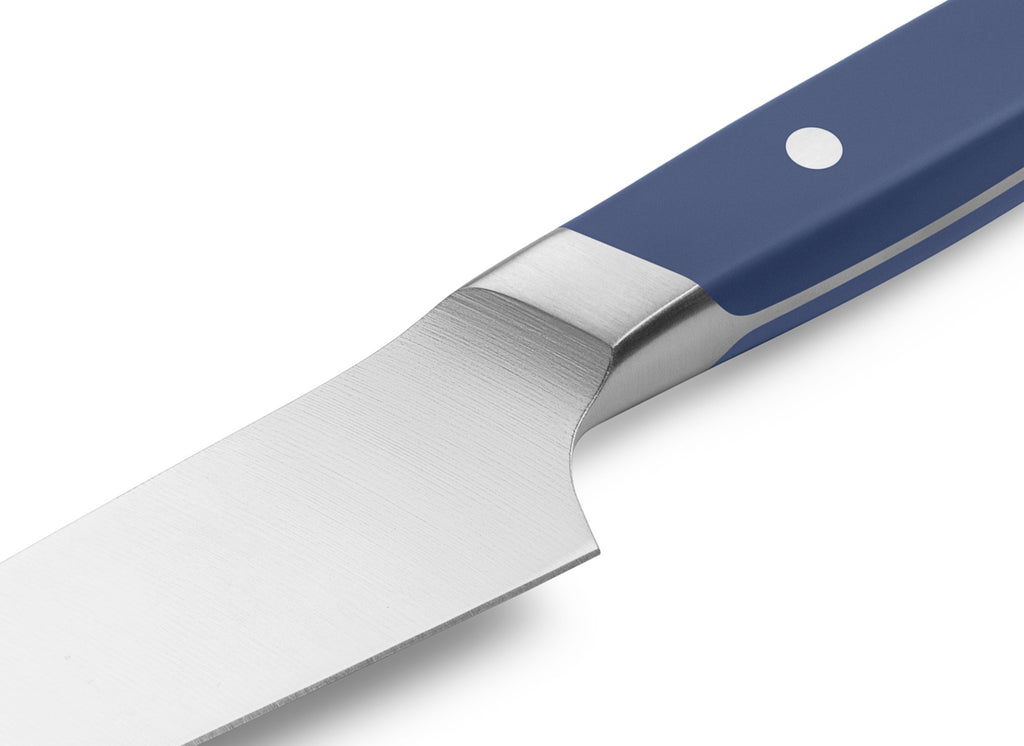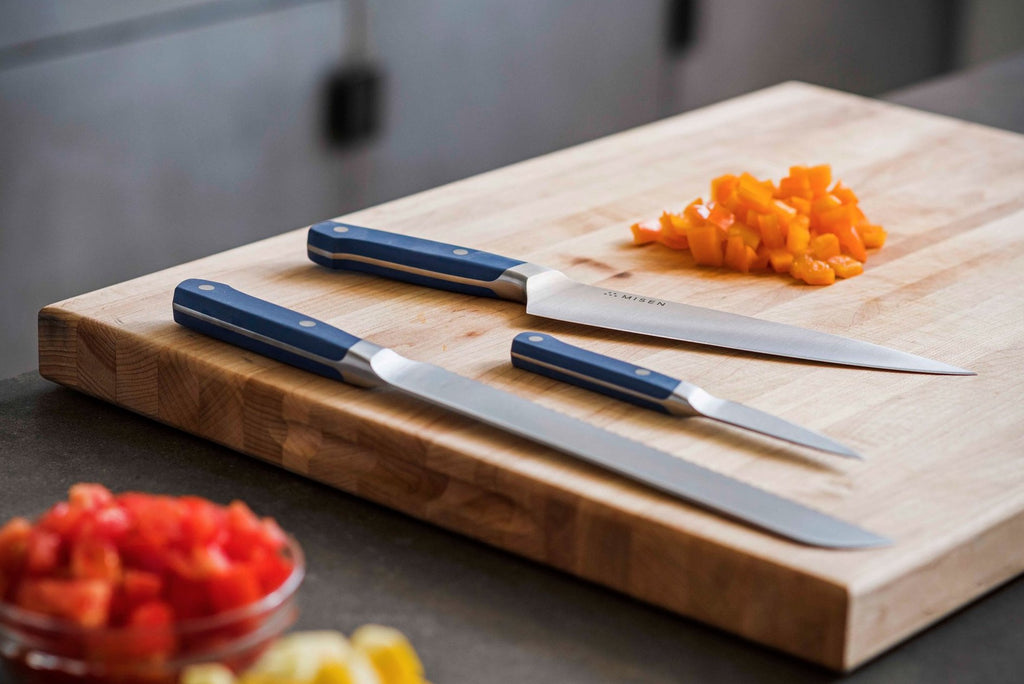Learn the Parts of a Knife and Know What to Look for When You Buy
 Knowing the parts of a knife will help you understand the features you want in the kitchen.
Knowing the parts of a knife will help you understand the features you want in the kitchen.
- Knives come in many forms, but they use the same terminology.
- Knowing what to look for in each part of a knife can help you choose a good one.
- Choosing a high-quality knife can make your life in the kitchen more fun.
Everybody knows what a knife looks like, but not everyone knows the different knife parts or the terminology to describe a knife's anatomy. However, whether you're describing a kitchen knife, a hunting knife, a folding knife, or any other kind, they share certain similar characteristics. Certainly, there are countless types of knives, but in general the terminology used in knifemaking is universal.
You don't have to be a pro chef, knife maker, or ninja to know all the names of the parts of a knife. However, knowing this terminology can help you make the right selection when choosing a knife for your kitchen.
Because we're a company that makes kitchen knives, we're going to focus on those in this article. But even if you're looking to get a bowie knife or a samurai sword, there are some valuable terms you can take away here. Essentially, we'll break down the knife into two easily recognizable parts: the blade and the handle.
Parts of the Blade
 A knife may look like one object, but it has many parts.
A knife may look like one object, but it has many parts.
The blade is the business end of the knife: the part that gets stuff done. This is the metal part of the knife, especially referring to the exposed metal that sticks out of the handle. And yes, while the blade is the term that encompasses this entire part of the knife, the blade itself has individual parts.
The Edge
The edge is the long, sharp part of the blade that does most of your cutting, whether you're using a chef's knife, paring knife, boning knife, or any other kind. The cutting edge is used to slice, dice, mince, chop, or do just about any other standard kitchen cutting job.
Though the blade shape may vary, the edge is almost universally the most important part of the knife. Different knives use their blades differently: For example, a bread knife is better than a chef's knife on food with a tough outside due to its serrated edges. However, both knives rely on their edge to get their job done.
A knife blade's sharpness is determined by its beveling: the angle at which the knife is ground down to the sharp edge. The lower the degree of the bevel, the sharper the blade. For example, a knife with a 25-degree bevel is not as sharp as a knife with a 15-degree bevel.
Most western kitchen knives are double-beveled, meaning they're sharpened on both sides. Some Japanese knives, like a santoku knife, are traditionally only beveled on one side. The Tip and the Point
The tip of the knife is just what it sounds like: the sharp, pointy end. This end of the blade is used for delicate cutting tasks that require great detail, like making garnishes or very small cuts. The point is useful for making holes in things: like poking small holes in a roast to insert garlic cloves, for example. Imagine it like a spear point.
The Spine
The spine is the unsharpened portion of the blade away from the edge. It's the thickest part of the knife — far thicker than the blade — and it gives the knife its strength. A knife with a thick spine will be able to take a lot of pressure compared to one with a thin spine.
The Heel
The heel is the part of the knife closest to your hand. This is where the blade ends and the knife turns upwards into the handle. The back end of the heel will be unsharpened, similar to the spine since you don't want to cut your hand on it.
Most kitchen knives will have a pronounced heel. So you don't injure yourself, they put some space between your hand and the blade. Other knives, like steak knives or pocket knives, may not have a heel at all.
Parts of the Handle
 You want a sturdy handle you can easily grip.
You want a sturdy handle you can easily grip.
Now that we've examined the blade, let's look at the other indispensable part of a knife: the handle.
The Tang
One of the most important parts of the handle is its connection to the blade: whether it's a full tang or partial tang.
The tang is the unsharpened part of the blade that leads into the knife handle. A full tang knife has its metal part extend all the way to the end of the handle and is generally much stronger than a partial tang knife. Because the metal goes all the way through the handle, the knife has a much lower risk of being damaged during heavy use. For kitchen knives or any heavy-duty knife, a full tang knife is the sturdiest way to go.
You can distinguish a full tang knife by seeing metal at the end of the handle. The spine should run through the handle all the way to the back of the knife. A partial tang knife will not have metal visible through the handle — unless it’s a hidden tang knife, which the manufacturer would let you know about.
The Rivets
The rivets are the small, crucial connections that keep the blade and the handle together. Rivets may come in many styles, but their function is the same: They keep your knife together. Without them, you'd have a blade with no handle and, let's be honest, that's no good for anyone in the kitchen.
The Scales
The material that makes up a knife handle — technically known as the scales in a full tang knife — can be wide and varied, though wood, plastic, and steel are the most common.
The most important part about a kitchen knife's handle material is that it's comfortable to grip and doesn't easily get slippery. This is especially true when the handle of the knife is wet, which often happens in a kitchen when fruits, vegetables, and hands are frequently getting washed.
The Bolster
The bolster sits where the blade meets the handle as a strengthening element for the entire knife, though some bolster shapes can get in the way of electric knife sharpeners. The knife bolster can sometimes serve as a spacer between the blade and the handle. Traditional Japanese-style knives don’t have a bolster, though some brands are now adding them and redesigning bolster shapes to create a hybrid of Japanese-style and Western-style knife designs.
A bolster allows you to apply lots of pressure on the blade with your hand without endangering yourself or the integrity of the knife. Recall that the word “bolster” as a verb means to strengthen, and that certainly applies to kitchen knives as well.
Although many knives come with a full bolster, a sloped bolster provides some serious advantages. Notably, it allows for a more effective grip — something we like to call the pinch grip. The pinch grip allows for greater precision when cutting since your hand gets closer to the business end of the knife rather than holding on clumsily to the handle. To accomplish the pinch grip, simply put your thumb and first knuckle of your index finger on the bolster and you'll have much greater control over your cuts.
The Pommel
The pommel — otherwise known as the butt of the knife — is the opposite end of the knife from the point. It can come in many shapes and isn't used all that often in cooking, though in general you want it to be sturdy. Ideally, the pommel will stick out towards the end to allow for extra grip.
What to Look For?
 A good knife has lots of boxes to tick.
A good knife has lots of boxes to tick.
When you're looking for high-quality cutlery, ask yourself a few important questions:
- Is the blade sharp?
- Is the knife full tang or does it have enough tang for my purposes?
- Is the spine wide enough to be able to take some pressure?
- Is the blade well-connected to the handle via rivets?
- Is the bolster sloped or an otherwise functional shape?
- Is the steel high-quality?
The last part hadn't been mentioned yet — but the quality of the steel is crucial to the quality of the blade as well. As Benjamin Franklin once phrased it, "There never was a good knife made of bad steel."
You don't need super-expensive, legendary Damascus steel or higher maintenance carbon steel to get the job done, but you do want good-quality stainless steel, like a high-carbon stainless steel knife, that will last you ages if you take care of it.
Caring for Your Knives and Yourself
The best way to keep your knives in good shape is to wash them properly and keep them stored safely. That's why we recommend always washing your knives by hand and drying them right away, followed by safely storing them.
Good knives are about the best thing to ever happen to a kitchen. If you don’t currently have some, do yourself a favor and upgrade your kitchen cutlery. You'll wonder why you ever used anything else.








